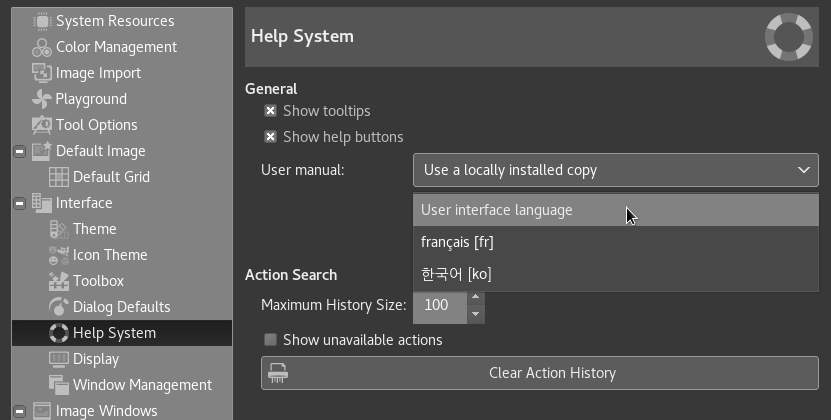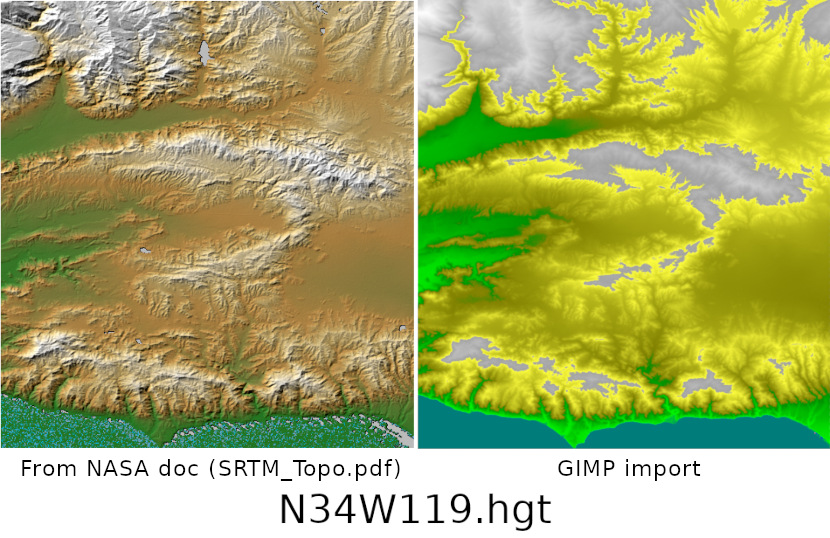Newly released GIMP 2.9.8 introduces on-canvas gradient editing and various enhancements while focusing on bugfixing and stability. For a complete list of changes please see NEWS.
On-Canvas Gradient Editing¶
One of the most user-visible changes in 2.9.8 is the updated Blend tool. Here’s what’s new about it.
First of all, it pretty much eliminates the need for the old Gradient Editor dialog, as all of the dialog’s features are now available directly on the canvas. You can create and delete color stops, select and shift them, assign colors to color stops, change blending and coloring for segments between color stops, create new color stops from midpoints.
Secondly, default gradients are now “editable”. As you probably know, the reason most resources such as brushes, painting dynamics, and gradients are not direclty editable is that they are typically installed into a system directory where non-privileged user can’t make any changes.
Now when you try to change an existing gradient from a system folder, GIMP will create a copy of it, call it a Custom Gradient and preserve it across sessions. Unless, of course, you edit another ‘system’ gradient, in which case it will become the new custom gradient.
Since this feature is useful for more than just gradients, it was made generic enough to be used for brushes and other types of resources in the future. We expect to revisit this in the future releases of GIMP.
Now that 2.9.8 is out with the updated Blend tool, we are interested in your feedback, as we still expect some cleanup and enhancements to be done there.
Most of the programming was done by Ell, however we also want to acknowledge two other people who contributed to that effort one way or another.
Michael Henning improved the Blend tool for 2.9.2, making the position of its endpoints editable before applying the gradient fill.
Michael Natterer refactored source code of GIMP’s tools to make them reuse one another’s on-canvas handles. That greatly simplified adding on-canvas handles for color stops. He also added the generic on-canvas dialog with the most important options for tools.
Clip Warning¶
Ell also implemented a feature request made in our public mailing list, where Elle Stone asked for some way to visualize underexposed and overexposed areas of a photo, which is a common feature in digital photography tools such as darktable and RawTherapee.
The new Clip Warning display filter targets that use case and fills underexposed and overexposed areas with user-configurable colors. For now, it’s mostly geared towards images where colors are stored with floating point precision. You will mostly benefit from this, if you work on 16/32 bit per channel float images such as EXR and TIFF.
Implementing this feature as a display filter has certain disadvantages such as having to go through the whole routine of adding a display filter for every image. We are thinking of better ways to do this.
Color Management¶
GIMP now uses the babl library for doing conversion of images between color spaces when matrix-based ICC profiles are used. This leads to completing transforms ca. 5 times faster in comparison to LittleCMS v2 on a few test images we tried this on. We expect to make further use of babl for doing color transforms once the library supports ICC profiles based on lookup tables.
Wayland support¶
While we already had the screenshot plug-in working under GNOME/Wayland, we now implemented screenshots for KDE/Wayland (though it misses rectangular area selection).
The Color Picker widget will now also work in KDE/Wayland. Note that there is still no color-picking interface in GNOME for Wayland, so as a workaround, color picking will only work inside GIMP windows for this platform.
Color-picked and screenshot pixels are not color-managed yet in Wayland.
Paste in Place¶
Michael Natterer implemented another small feature request from a user who asked for an Inkscape-like Paste in Place command. The idea is that GIMP should be able to paste contents of the clipboard at exact coordinates the contents was originally copied from. This feature is available for both the regular clipboard and named buffers.
Paste in Place complements the usual Paste command which places contents of the clipboard into the center of the viewport.
GUI and Usability¶
The spinscale widget now highlights vertical parts of the slider section differently to hint that position of cursor above the widget matters. When changing values in the lower step section, the pointer will be wrapped around the screen so that you could continue adjusting the value without interruptions.

When using transform tools, you can now press a modifier key before or after pressing/releasing a mouse button.
The Info window for the color picker now remembers the modes across session. So if you prefer seeing LAB values, that’s what you will see every time until you choose something else.
Canvas rotation and flip information is now visible in the status bar, as angle value and flip icon. Clicking on these canvas statuses will respectively raise the Select Rotation Angle dialog or unflip the canvas.

Help Manuals¶
Upon detection of locally installed manuals in several languages, GIMP will now allow selection of the preferred manual language in the Preferences dialog (Interface > Help System).

This is especially useful since GIMP’s interface is available in 80 languages, while its manual is translated to only 17 languages. You may therefore not have a choice of viewing the manual in your preferred language.
Moreover, some people choose English over their native language for user interfaces, while sticking to their native language for reading documentation. This is another case where choosing preferred language for the user manual might come in handy.
Improved Wavelet Decompose Filter¶
The much demanded Wavelet Decompose filter got a small round of updates and gained a couple of new options: placing decomposition stack into its own layer group and adding a layer mask to each scales layers. It also produces more expected results now.
File Formats¶
The PSD plug-in was fixed to properly handle Photoshop files with deeply nested layer groups and preserve expanded state of groups for both importing and exporting. Additional changes fix mask position and improve layer opacity for importing/exporting.
The PDF plug-in now supports loading password-protected files by promting the user for password.
HGT files can now be imported. HGT is the format for Digital Elevation Model data by the NASA and other space agencies. GIMP now supports both the SRTM-1 and SRTM-3 types (as far as we know, the only two variants) which will be imported as grayscale RGB images.

In order to obtain more visible relief information, you will want to map altitudes to colors, for instance with the “Gradient Map” filter as we did in the example image above (see also this explicative post on the process).
Translations¶
Translation of GIMP was updated for 13 languages: Catalan, Croatian, Galician, German, Greek, Hungarian, Icelandic, Indonesian, Italian, Polish, Russian, Spanish, and Swedish.
What’s Next¶
We’ll enter strings freeze soon so that translators could safely finalize their work for 2.10. Following that we expect to start making release candidates of GIMP 2.10.